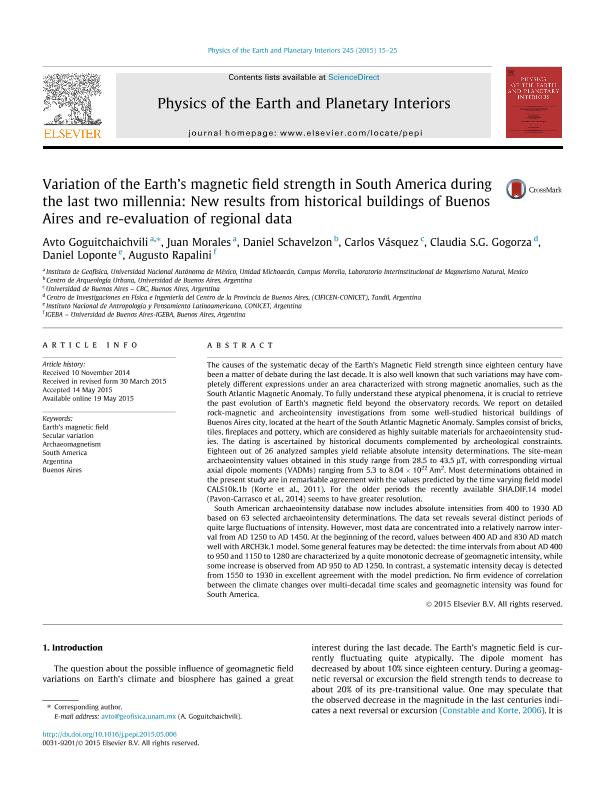Artículo
Variation of the Earth's Magnetic Field Strength in South America During the Last Two Millennia: New results from Historical Buildings of Buenos Aires and Re-evaluation of Regional Data
Goguitchaichvili, Avto; Morales, Juan; Schavelzon Chavin, Daniel Gaston ; Vasquez, Carlos Alberto
; Vasquez, Carlos Alberto ; Gogorza, Claudia Susana
; Gogorza, Claudia Susana ; Loponte, Daniel Marcelo
; Loponte, Daniel Marcelo ; Augusto Rapalini
; Augusto Rapalini
 ; Vasquez, Carlos Alberto
; Vasquez, Carlos Alberto ; Gogorza, Claudia Susana
; Gogorza, Claudia Susana ; Loponte, Daniel Marcelo
; Loponte, Daniel Marcelo ; Augusto Rapalini
; Augusto Rapalini
Fecha de publicación:
09/2015
Editorial:
Elsevier
Revista:
Physics of the Earth and Planetary Interiors
ISSN:
0031-9201
Idioma:
Inglés
Tipo de recurso:
Artículo publicado
Clasificación temática:
Resumen
The causes of systematic decay of the Earth´s Magnetic Field strength since eighteen century have been a matter of debate during the last decade. It is also well known that such variations may have completely different expressions under an area characterized with strong magnetic anomalies, such as the South Atlantic Magnetic Anomaly. To fully understand these atypical phenomena, it is crucial to retrieve the past evolution of Earth´s magnetic field beyond the observatory records. We report a detailed rock-magnetic and archeointensity investigations from some well-studied historical buildings of Buenos Aires city, located in the hearth of the South Atlantic Magnetic Anomaly. Samples consist of bricks, tiles, fireplaces and pottery which are considered as highly suitable materials for archaeointensity studies. The dating is ascertained by historical documents complemented by archeological constraints. Eighteen out of 26 analyzed samples yield reliable absolute intensity determinations. The site-mean archaeointensity values obtained in this study range from 28.5 to 43.5 µT, with corresponding virtual axial dipole moments (VADMs) ranging from 5.3 to 8.04 1022 Am2. Most determinations obtained in the present study show remarkable agreement with the values predicted by the time varying field model CALS10k.1b [Korte et al. 2011]. South American archaeointensity database now includes absolute intensities from 400 to 1930 AD based on 63 selected archaeointensity determinations. The data set shows several distinct periods of quite large fluctuations of intensity. However, most data are concentrated into a relatively narrow interval from ad 1250 to ad 1450. At the beginning of the record, values between 400 AD and 830 AD match well with ARCH3K model. Some general features may be detected: the time intervals from about AD 400 to 950 and 1150 to 1280 are characterized by a quite monotonic decrease of geomagnetic intensity, while some increase is observed from AD 950 to 1250. In contrast, a systematic intensity decay is detected from 1550 to 1930 in excellent agreement with the model data. No firm evidence of correlation between the climate changes over multi-decadal time scales and geomagnetic intensity was found for South America.
Archivos asociados
Licencia
Identificadores
Colecciones
Articulos(CIFICEN)
Articulos de CENTRO DE INV. EN FISICA E INGENIERIA DEL CENTRO DE LA PCIA. DE BS. AS.
Articulos de CENTRO DE INV. EN FISICA E INGENIERIA DEL CENTRO DE LA PCIA. DE BS. AS.
Citación
Goguitchaichvili, Avto; Morales, Juan; Schavelzon Chavin, Daniel Gaston; Vasquez, Carlos Alberto; Gogorza, Claudia Susana; et al.; Variation of the Earth's Magnetic Field Strength in South America During the Last Two Millennia: New results from Historical Buildings of Buenos Aires and Re-evaluation of Regional Data; Elsevier; Physics of the Earth and Planetary Interiors; 245; 9-2015; 15-25
Compartir
Altmétricas



